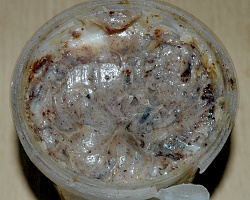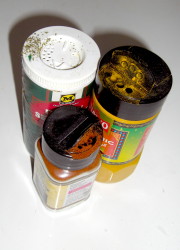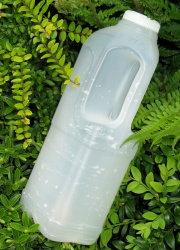How can I reuse or recycle old kitchen fat?
 Since we do what we’re told by our water company, we don’t pour meat fat from cooking down the sink – we scrape/pour it into an old plastic container instead. The gross pot full in the picture is a combination of lots of fat from lots of different meals for the last couple of months, ick.
Since we do what we’re told by our water company, we don’t pour meat fat from cooking down the sink – we scrape/pour it into an old plastic container instead. The gross pot full in the picture is a combination of lots of fat from lots of different meals for the last couple of months, ick.
When we started our collection, we thought we’d use it to make bird feeders this winter – the fat is solid at room temperature, let alone at the minus-something temperatures we’ve got at the moment, so we were going to fill it with nuts and seeds to make fat balls for the local wildlife. But then I read that you shouldn’t use reused meat fat to make fat balls – because it’s prone to smearing and can cause them problems when cleaning their feathers. Does anyone know if this is true?
If it is, shucks, there goes our reuse idea. Is there anything else we can do with it instead? Are any particular fats (eg, bacon fat) more reusable?
(Incidentally, the bird feeding stuff fits into something I wrote about on The Really Good Life yesterday – asking about alternatives to shop-bought bird feed for wild birds — do pop over and read it if you feed birds!)
























we don’ have lots of fat – don’t eat much meat – but we’ve tried making our own bird balls and i think our garden visitors are too snooty – they wouldnt touch it.
But you might try to make tallow candles you’ll need to melt & filter out the yucky bits before moulding/adding scents etc.
You could also make your own soap – there are a number of very good sites walking you through the process – and there’s also a very handy “fat calculator” somewhere (can’t put my hand on the link at the moment) that automatically calculates how much of what type of “fat” to use for X amount of catalyst etc.
The RSPB says beef suet and lard (pork fat) are fine. Having said that, I made a fat feeder from the bottom of a plastic bottle, filled it was lard and seeds and the little blighters have totally ignored it!
Here’s a link to the RSPB’s advice, scroll down for the info — http://www.rspb.org.uk/advice/helpingbirds/feeding/whatfood/index.aspx
The other fats can be dumped into the newspaper and added to a municipal green bin.
I would keep the bacon fat in a separate container in the fridge and use it to cook with. It will add loads of flavour to stuff and the fats will help you feel more full so that you will need to eat less. Bacon is perfect for frying up perogies, making popovers, making home fries, sauteeing onions…
I think it’s mostly pork fat (mmm bacon) so I might try making fat balls after all – then see if we’ve got snooty birds like Alexis and Clare ;)
Thanks for confirming what I thought about bacon fat, Leanne – we’ll keep it separate from now on.
My grandad used pork and beef fat for birds. Whatever birds he had around apparently ate it anyway.
I wonder would the animal based fats work in making home made diesel the same way the vegetable oils can be turned to that?
Yes you can use animal fats to make bio-diesel. Duck fat is particularly good
We blend the solids 50/50 with vegetable oil but only in the summer to prevent the waxing issue or you would need to use a waxing inhibitor.
The fat should be flamable and as such could be used as a component for replacing fuel in a barbeque (only really suited for producing heat outdoors due to the smells and smoke that may be produced). Fat has a high energy conent so should burn but would probably need to be mixed with more conventional fuel before it would be suitable.
We had great success making garden candles using old fat we’d drained from a mixture of meat types collected, as you do, in plastic pots whilst cooking. We kept such pots in the freezer until we had enough to make rendering worth the effort; three or four. If you don’t freeze them and the fat goes off, the smell is quite unbelievable.
To render, slowly boil the old fat for about an hour and then allow it to cool solid. I must warn you, it’s a smelly business. The clean fat floats atop the nasty stuff you don’t want, so once it’s fully cooled just lift it off and give it a quick wash under a cold tap. What you should have now is a cake that feels a bit like soap and has little to no smell. To make your candle, simply melt the cake down again and pour into an old, cleaned tin can. A suitable wick, attached to some cross-member such as a pencil, can now be dangled into the hot fat. Once cool and again solid, the fat holds the wick in place. Please keep it in mind that this fat really is very hot when molten.
The candle burns cleanly and without any smell for a surprisingly long time and they look really cool. The next time we make a batch I want to try adding a few drops of citronella oil to add a lemony aroma, said by some to be an effective mosquito repellent.
I save bacon and sausage fat and cook with it. Saves on oil and butter. I love to fry veggies and stuff in it. Yum = D